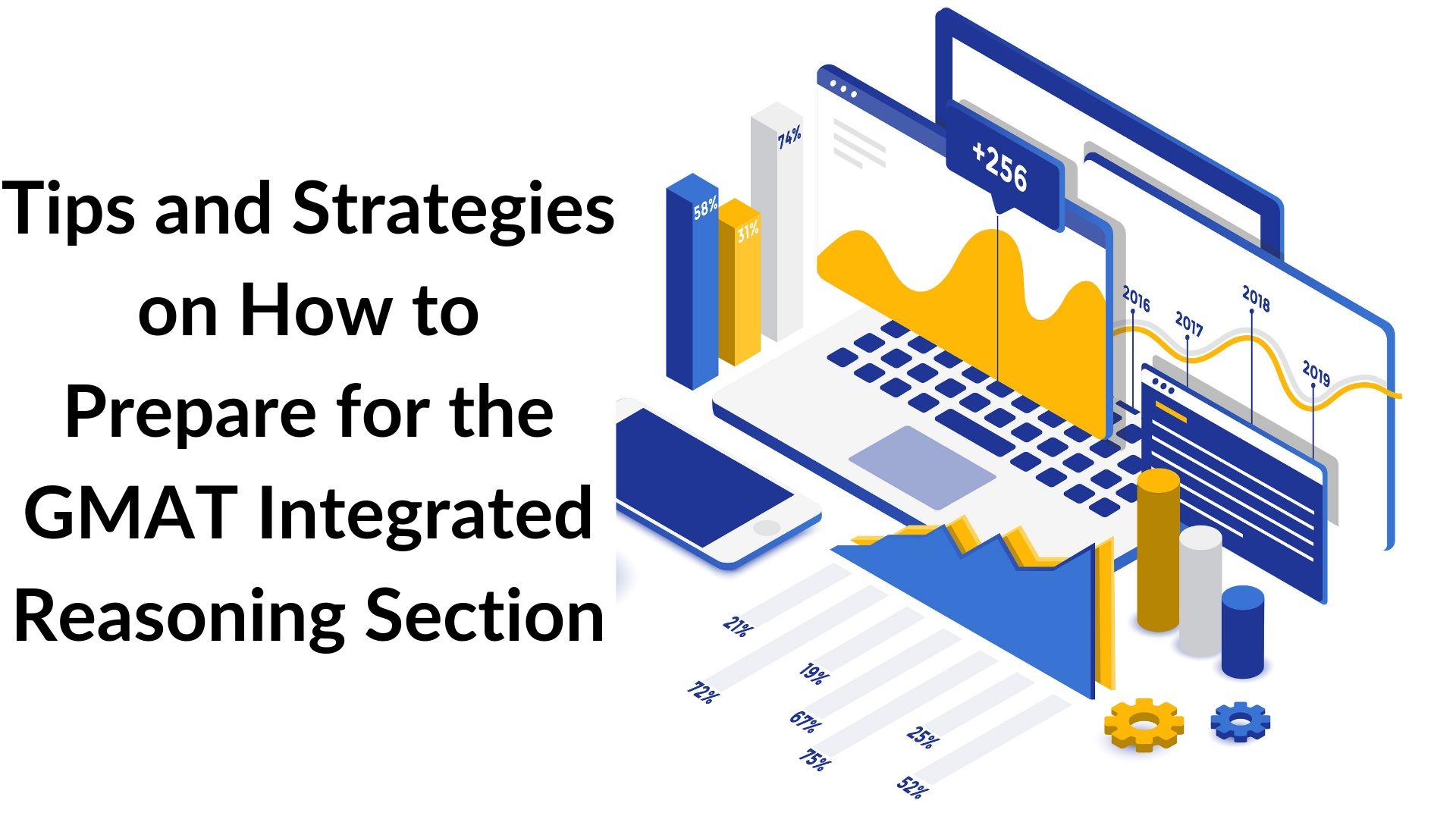The GMAT integrated reasoning section was introduced in 2012 with the aim of testing skills that are important for success both in business school and in real-life business situations. In the contemporary data-driven world, employers value business leaders who can sort through large amounts of data, determine what is most relevant and incorporate that into a strategic solution.
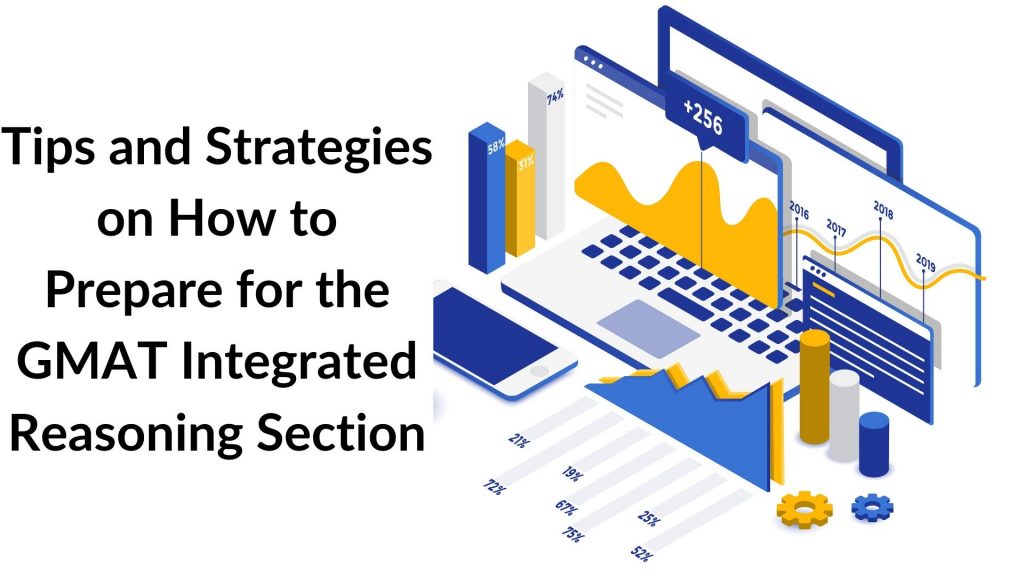
In this article, we explore how to best prepare for the GMAT Integrated Reasoning section. Here is a brief outline of the article:
- Basics about the GMAT Integrated Reasoning
- What are the different types of questions asked on the GMAT IR section?
- What is the purpose of the GMAT Integrated Reasoning section?
- How is the GMAT IR Section different as compared to the Quant and Verbal Sections?
- Tips/Strategies to prepare for the GMAT IR Section
What is Integrated Reasoning (IR)?
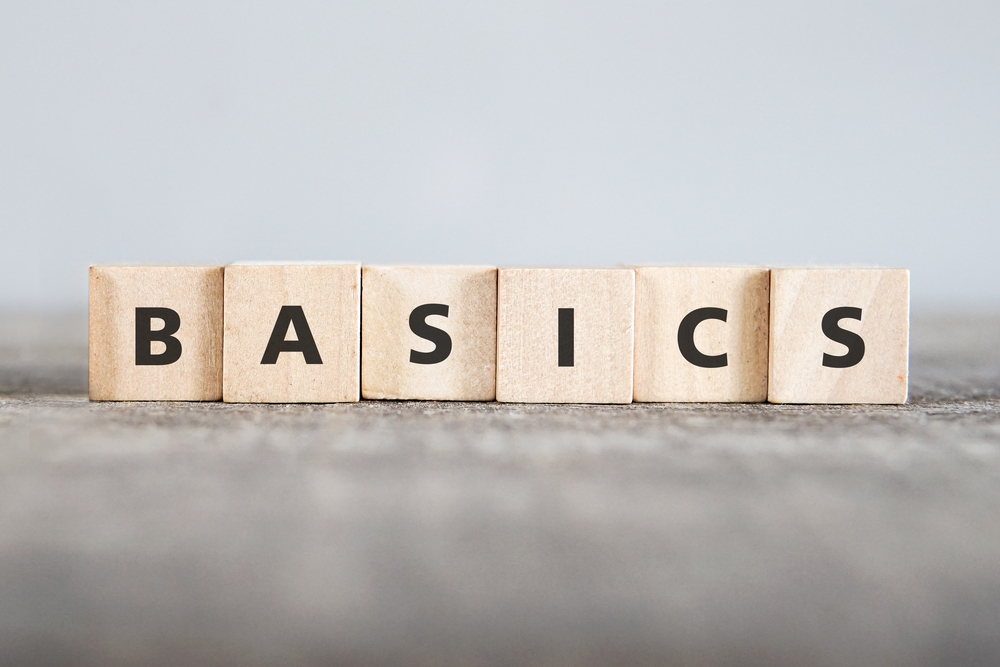
The GMAT integrated reasoning section was introduced by the GMAC in June 2012. It was introduced based on discussions with both business schools and employers about the skills that are important for success in the classroom as well as in the business world.
The section lasts for 30 minutes and consists of 12 questions of 4 different question types. The four different questions types in the GMAT integrated reasoning section are:
- Multi-Source Reasoning
- Table Analysis
- Graphics Interpretation
- Two-Part Analysis
The questions involve both quantitative and verbal reasoning, either separately or in combination and some questions will require more than one response. An online calculator with basic functions is provided to candidates only for the GMAT integrated reasoning section.
For more information on how the GMAT integrated reasoning section is scored read this article.
Purpose of the GMAT Integrated Reasoning Section
The purpose of the GMAT integrated reasoning is to test higher-order reasoning skills such as the ability to analyze data presented in different formats such as tables, charts, and graphs. Solving the questions requires a combination of both quantitative and verbal skills, hence the name integrated reasoning.
According to a survey conducted by GMAC in 2012, over 600 employers across the world consider the skills tested in the integrated reasoning section important for success in the business world.
Are you stuck at home with no GMAT Prep classes to go to? Why don’t you check out our Online GMAT course? Take a FREE Trial Today. We are the most reviewed Online GMAT Preparation Company with 1950+ reviews on the GMATClub
Importance of GMAT Integrated Reasoning Score in MBA admissions
In a survey of over 200 business school admission officials conducted in 2015, 59% said that an applicant’s GMAT IR score is an important part of their evaluation. Since the GMAT Integrated Reasoning section receives its own separate score, it can help candidates distinguish themselves in a positive way.
Read more about the importance of the GMAT score in MBA admissions here.
How is the GMAT Integrated Reasoning Section different from the Quant and Verbal Sections
The GMAT integrated reasoning section is different in the following ways as compared to the Quant and Verbal Sections:
- The GMAT IR section unlike the quant and verbal sections is not computer adaptive. Thus, you may get questions of different difficulty levels in a random manner.
- The GMAT integrated reasoning raw score is reported separately in 1-point intervals from 1-8. A percentile score based on historical 3-years of score data is also reported.
- A question may consist of 2-3 associated tasks, each needs to be answered correctly. No partial credit is awarded.
- Unlike the quant section, an online calculator with basic functionality is provided for the GMAT integrated reasoning section.
For more information on the computer adaptive quant and verbal sections of the GMAT read this article.
How to prepare for the GMAT Integrated Reasoning Section

Since the GMAT integrated reasoning section tests both quantitative and verbal skills it is imperative that you prepare well for the quant and verbal sections of the GMAT first. The following are some tips and strategies to prepare for the different question types in the GMAT integrated reasoning section.
GMAT Integrated Reasoning – Graphics Interpretation Questions
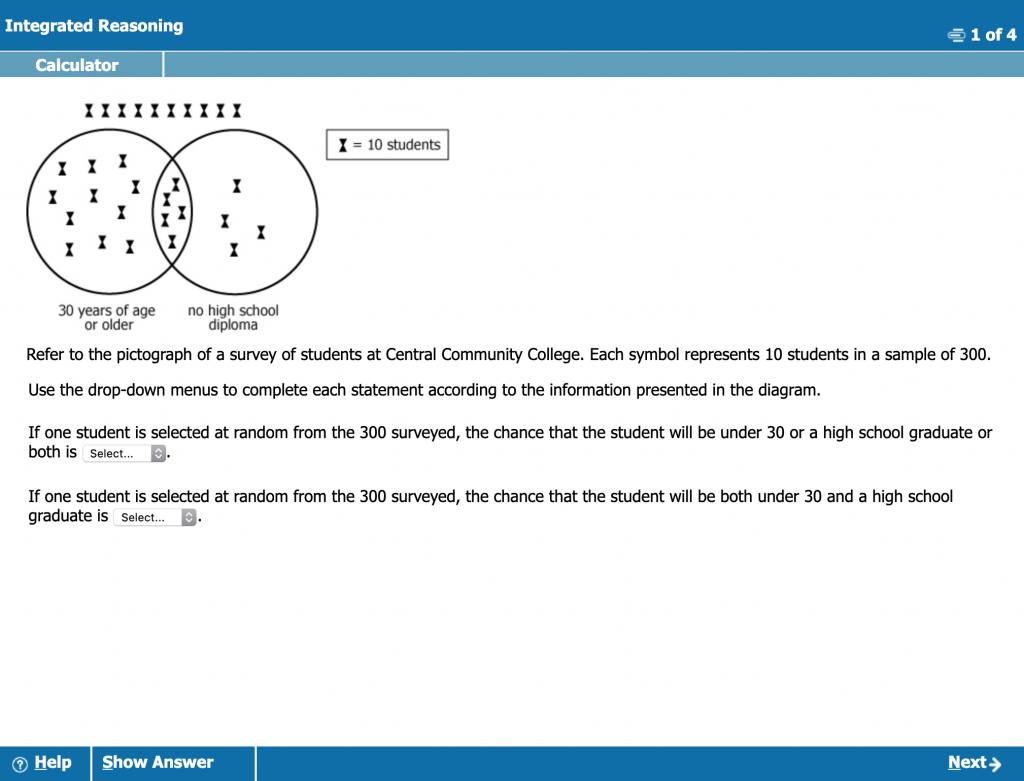
In graphics interpretation questions, test takers are presented data in the form of charts and graphs. Textual information supporting the charts and graphs accompanies the question.
A certain number of statements follow the question and each statement needs to be completed by selecting an answer from a drop-down menu that best completes the statement. A dropdown menu may contain up to 3-5 answer choices.
Tips to prepare for Graphics Interpretation Questions
- Read the accompanying text information carefully and try to understand the big picture the information is trying to paint
- Pay close attention to the units of measurement used in the question and in the statement.
- Try to identify possible trends and relationships between the data given in the question, such as spikes, inverse or direct relationships, etc.
- Check the required answer choices before proceeding with calculating the answer. The answer choices will give you an idea of what calculation needs to be performed and the accuracy required. For e.g. calculating absolute increase vs. percentage increase etc.
- Do not confuse numbers with rates or percentages.
- Familiarize yourself with the different ways in which data can be presented graphically such as pie-charts, graphs, etc.
GMAT Integrated Reasoning – Table Analysis Questions
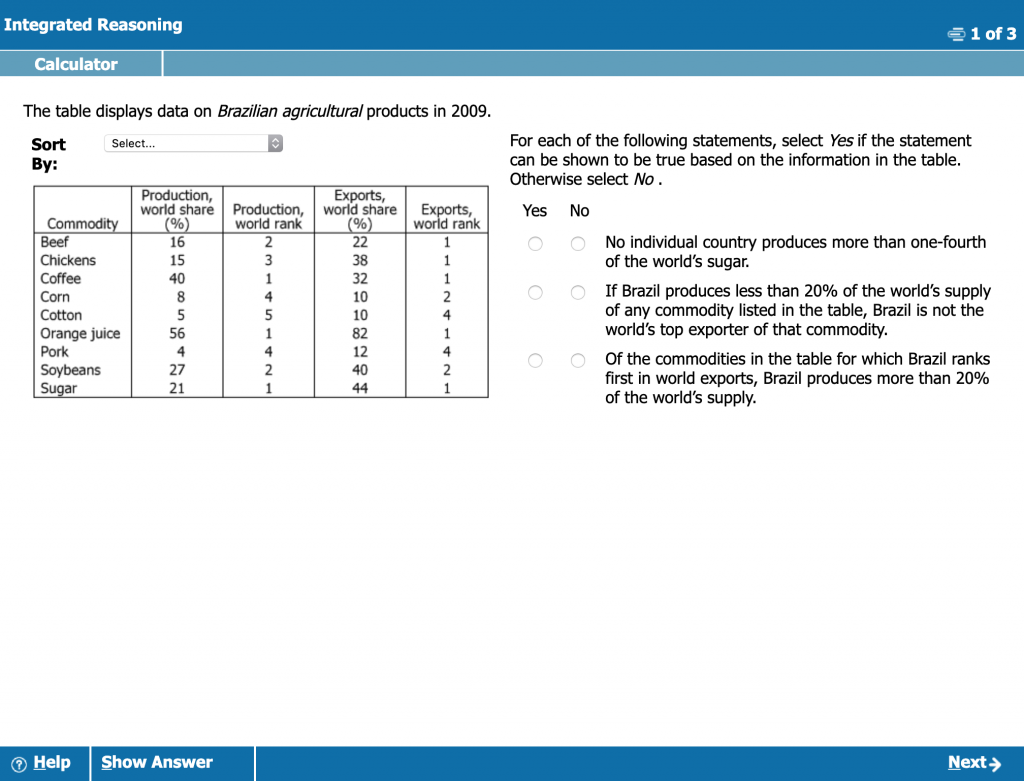
In table analysis questions data is presented in the form of a spreadsheet-like table. Using the data, you have to respond to statements that have two opposing answer options such as true/false, yes/no, supported/unsupported.
The table provided can be sorted by columns however no other type of spreadsheet-like functionality is provided. By default, the data is sorted by the leftmost column in the table.
Tips to prepare for Table Analysis Questions
- Read the column titles carefully and note down any columns that require further explanation.
- Read the accompanying text and look for information that clarifies any questions that arise from column titles.
- Make a note of the units and any calculations used to determine certain values in the table.
- Scan the table entries to get a general feeling of the big picture provided by the data. However, do not spend too much time in doing so.
- Do not spend too much time in identifying any patterns or trends in the data provided.
- Carefully read the question stem to fully understand the tasks. You can also create a summary of the directions. This is similar to the skills required for the reading comprehension section in GMAT verbal.
- Read the statements that follow and for each statement determine the information required to answer the question. This includes understanding which columns from the table will require a closer look.
- Determine the best way to sort the data for each statement. The sorting functionality is given for a reason. This prevents you from hunting for the information required to answer the question which can lead to careless mistakes.
- Remember to respond to each statement.
GMAT Integrated Reasoning Section – Two-Part Analysis Questions
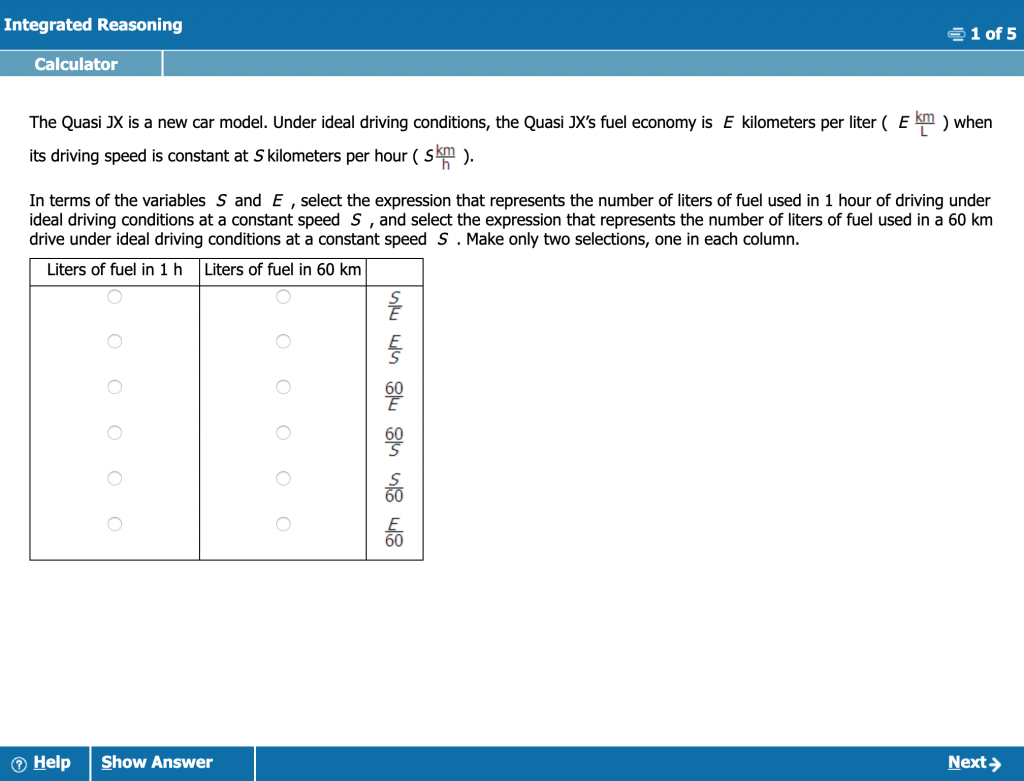
This question type presents text information to complete two tasks. Both these tasks share the same answer choices and there may be up to 5-6 answer choices in total.
Two-part analysis questions can be further sub-divided into 3 different types, they are:
- Quant Type Questions
- Critical Reasoning Type Questions
- Follow the Rules Type Questions
Tips to prepare for Two-Part Analysis Type Questions
- Scan the question to determine the question type, here are a few pointers you can use to determine the same:
- Scan for numbers or algebraic expressions to determine if it is a quant type question
- Read the question stem and look for keywords such as infer, conclude, assume, etc. to determine if it’s a critical reasoning type question
- Proceed to carefully read the information in the given passage. Summarize the information provided in the question. This applies to both quant and critical reasoning type questions.
- To follow the rules type questions summarize the rules provided in the text passage.
- For critical reasoning type questions identify the premises and conclusion.
- Carefully reread the question stem to determine the required tasks and do not rely on the column headings to give direction.
- Determine if the tasks are dependent or independent of each other, i.e. if the value of one answer determines the value of the other.
- If the tasks are dependent, then look for an approach that relates the two answers. For e.g. in a quant type question with dependent tasks, using a system of equations based approach would work best as it would effectively relate the two answers.
- If the two tasks are independent then you should tackle the easier task first. Since this may give you an additional insight that may be helpful in solving the harder task.
- Proceed to apply the most appropriate technique to solve the question based on the question type.
- If you’re familiar with the subject matter of the question remember to use only the given information to solve the tasks. Remember that the GMAT does not require knowledge of any outside information to solve the question.
- Lastly, remember that the same answer choice can be correct for both columns.
GMAT Integrated Reasoning Section – Multi-Source Reasoning Type Questions
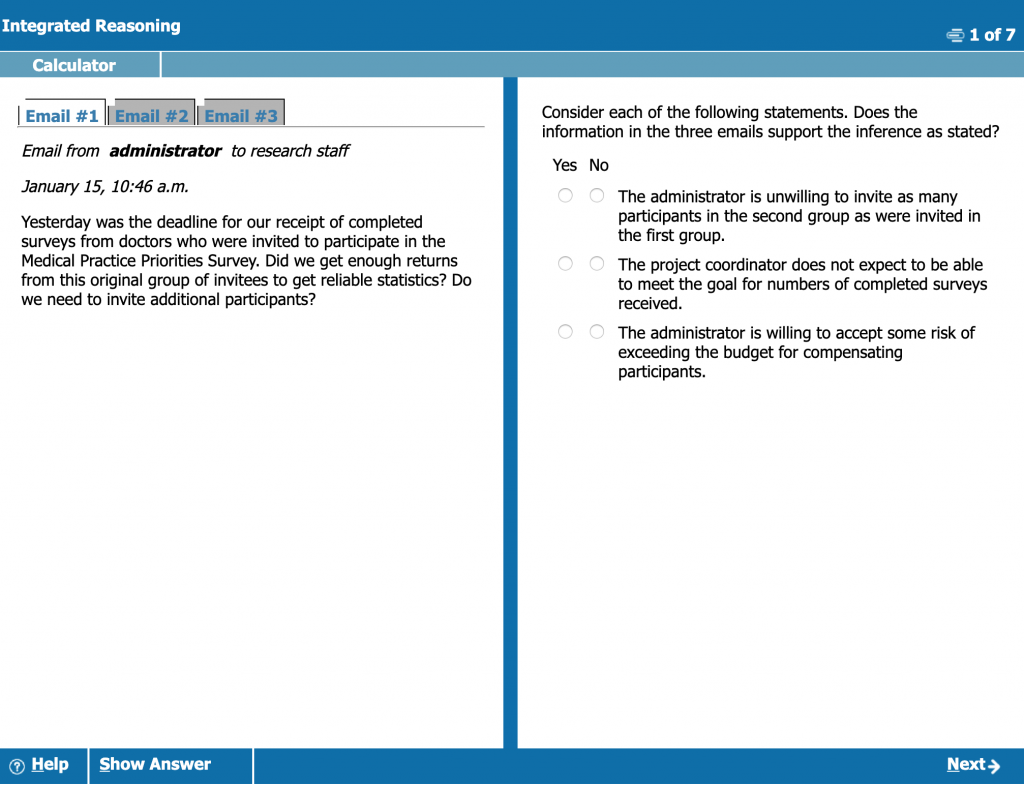
In Multi-Source Reasoning type questions, data is presented in the form of 2-3 tabbed pages. The information provided can include text, tables or graphics. Along with the tabbed pages on half of the screen, the corresponding tasks are presented in the other half of the computer screen.
The tasks may be a multiple-choice question or a set of statements with opposing answer choices such as yes/no, true/false, etc. There may be more than one set of tasks for a given information source.
Tips to Prepare for Multi-Source Reasoning Questions
- Read the question/questions before examining the given information. This is important for 2 reasons:
- Since this question type contains far more text than any other question type, reading the question first will help you focus on the important pieces of information while reading the text. It will also help in preventing you from getting lost in the information.
- Additionally, reading the question first will help you in getting a better idea of the story the data is trying to tell. This additional context makes it easier to digest the information provided in the tabbed pages.
- Be fully engaged with the content while reading the information in the tabbed pages. This is similar to the strategy used while reading RC passages.
- Make sure to look for information that answers the question while you are reading the content. Summarizing key information is a useful step here, similar to the RC strategy.
- Another reason why summarizing is important is that you are required to complete 3 or more different tasks. Summarizing will help you determine where to look while solving different tasks.
- Another tip is to divide your scratchpad into different columns, one for each tabbed page of the information provided. This will help you note down the general summary of the information provided on each tabbed page.
- If you do find the information to answer a particular question while reading the content provided on a tabbed page do not stop reading to answer the question. It may so happen that there may be additional information provided later on that would affect your answer choices.
- Thus, only after you’ve completed reading through the information provided on all the tabs, proceed to complete the first set of tasks, then the second and so on.
Integrated Reasoning GMAT Tips | Summary
- Get accustomed to interpreting data presented in the form of charts, graphs and other types of graphical representations.
- Read the question stem carefully and do not confuse percentages and rates given in question.
- Not all data given along with the question will be useful. Thus, learn to quickly identify what information is necessary to answer the question. (A skill developed with practice)
- Get familiar and practice all the different question types as mentioned above. Once you are done practicing, always review your attempt for errors so that you do not make the same mistakes during the actual test.
- Do not skip the IR section while given full-length mock tests. This will help build a familiarity and rhythm while solving different type of Integrated Reasoning questions.
- Take advantage of the sorting functionality as well as the on screen calculator if and when required during the test.
- In certain question types, it is important to summarize all the information given before you begin to solve the question. Thus make it a habit to summarize the information given.
- The answer to some questions may be dependent on the answer to a previous question. Thus, follow a step-by-step approach to solving questions.
- Pay special attention to the units used in the question and any conversions you might have to make while solving for any particular question.
- Lastly, learn when to guess and move on from certain questions after you have spent more than adequate time solving them. Remember the GMAT IR section is timed just as all other GMAT sections.
The e-GMAT course contains over 15+ hours of quality video content to help you prepare for the GMAT integrated reasoning section. Signup for a free trial of the e-GMAT course here.
We are the most reviewed GMAT preparation company on GMATClub with over 1950+ reviews. We can also help you with a personalized GMAT study plan, reach out to us acethegmat@e-gmat.com with any queries.
Here are a few more articles related to GMAT Integrated Reasoning that you may find useful:


